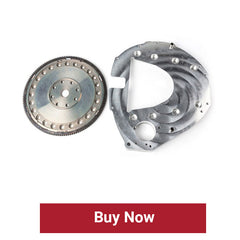
Ford Cummins Conversion and Why It's So Popular
Enjoy a Better Ride with a Ford Cummins Swap
Although many drivers appreciated the luxurious interiors of Ford trucks, their engines often were not as highly regarded, which made the Ford Cummins swap a popular solution over the years. Over time, the problems with the 6.0 Ford Powerstroke engine became well known. Many experts felt that most of these issues stemmed from the original design.
Common concerns include:
- The factory EGR system for emissions standard compliance
- The 6.0 head studs, which did not have enough clamping force and caused blown head gaskets
- HPOP failure
- Injector stiction
- Oil coolers clogging
- FICM failure

Even though everyone considered the 6.0 the "problem child," the 6.4 did not provide enough improvement. In the 6.4, the EGR system still needed improvement. The fuel system had corrosion issues, turbo pipes cracked, plus there were oiling issues. For these reasons, many people elect to swap a Cummins into their Ford truck. A Ford Cummins Swap is an excellent option for those who want the loaded interiors of Ford trucks with Cummins engines' reliability. The Cummins engines are powerful yet simple. Plus, they are very reliable and reasonably priced. For these reasons, a Ford Cummins conversion or Fummins swap is an ideal diesel conversion for Ford trucks.
Why the Cummins?
Dodge began to outsource manufacturing of their heavy-duty truck motors to the world-renown company Cummins in 1989, and the Cummins 6BT was the result. Dodge first used the 5.9L Cummins motor in their RAM trucks starting in 1989. They built the truck around the engine, which allowed them to meet the expectations of even the most demanding consumer. Initially sold with a mechanical Bosch VE injection pump, the diesel was reliable but underpowered compared to today's standards. With 160hp and 400 ft-pounds of torque, the motor was well-suited for the first RAM truck.
Thanks in part to the mechanical Bosch VE injection pump and mechanical timing, swapping this first-generation motor is reasonably straightforward, requiring only one electrical hookup and fuel hookup. Although sluggish in stock form, when modified correctly, the 5.9L Cummins produces over 600 horsepower.
The Cummins engine was known for simplicity. The 12V version took only a few wires to run since most components on it were mechanical. Eliminate the electronics and other problem-causing factors, and you have a reliable, simple engine ready to swap into anything that can hold its weight.
Ford Cummins Aftermarket
Because of its popularity, Cummins Conversion components are a thriving aftermarket. The following parts make a Fummins Swap possible:
- Transmission adapter kits, which include transmission adapter plate and flexplate
- Swap kits
- Exhaust systems
- Fuel components
- Cooling system components
- Motor mounts
- Wiring
- Sensors
Ford Cummins swap compatibility
The 12 valve Cummins is the simplest of the group. Introduced in 1998, the 24V Cummins is more powerful but has more electronics. Next, in 2003, the Commonrail Cummins came out, which had a high-pressure fuel rail. All of these engines are prime candidates for a Ford Cummins swap. However, you must use a Ford Cummins conversion kit to make the swap possible. It was the most popular in the 6.0 Ford truck. However, enthusiasts also did the Fummins swap in 7.3 and 6.4 trucks. Cummins Swap Kits also are available to adapt a Ford 5r110 automatic transmission, Allison 1000, and early Chevy transmissions.
Adapter Kits make things easier
Without an adapter kit to mount a Cummins to a Ford, Chevy, or Allison transmission, it would be challenging to do a Cummins Conversion. Motor mounts and other swap components make the swap straightforward. A few companies offer complete Cummins Swap kits. These kits might seem expensive at first, but they save time and frustration in the long run.More Fummins Swap Information
G Force has three different options for an engine to transmission adapter kits to complement other components for your Cummins conversion:
- 5r110
- Allison 1000
- Early Chevy transmissions.
Ford Cummins Swap with 5R110 Transmission Adapter Kit
The 5r110 is a 5-speed automatic introduced in 2003. It held quite a bit of power and was a reliable transmission. The gear ratios are as follows:
Gear Ratios:
1st: 3.09 2nd: 2.20 3rd: 1.54 4th: 1.09 5th: 1.00 6th: .71 (overdrive)
This transmission was electronically controlled and had a lot of features such as “cold mode” and “limp mode.”
You can see the G Force Cummins to Ford transmission adapter swap kits here.
Cummins Allison | Transmission Adapter Kits
The Allison 1000 transmission was introduced in 1999 and offered in 2001 to present production trucks. The Allison 1000 transmission was behind primarily the Duramax engine. It is a powerful transmission and perfect for a Cummins Conversion. The older Chevy transmissions are not the strongest, but they are an option behind a moderate power Cummins. For example, the 4L80e can be used as part of a Cummins swap. See our Cummins Allison transmission adapter kits here.
Cummins to Chevy Swap—Transmission Adapter Kits
For a Cummins to Chevy swap, G Force offers three swap adapter kits—the 2003-2017 Cummins to TH400/4L80E (GF-C-SL), 1989-2002 Cummins to TH400/4L80E (GF-C-S), and 1973-1987 GM K Series Cummins Kit (GF-GMK3-Kit).
For more about a Cummins swap, check out these blog articles—Diesel Cummins Conversion, Cummins Allison| A Popular Conversion, Which 6BT Cummins is Best for Your Swap, 24 Valve 5.9 Liter Cummins Specifications, and 12 Valve 5.9 Liter Cummins Specifications.
If you're looking to complete a Cummin Conversion, our dedicated team of transmission adapter experts is here for you.





